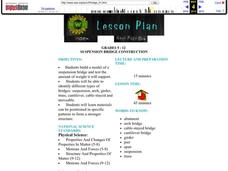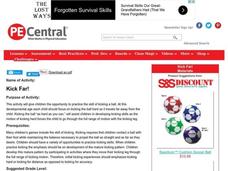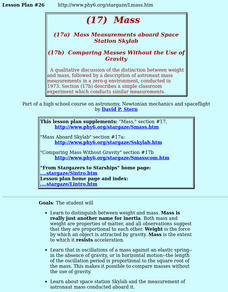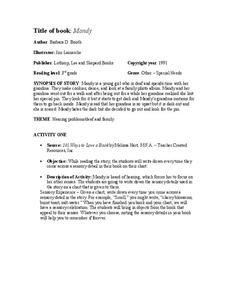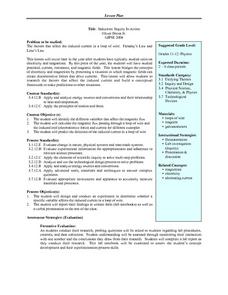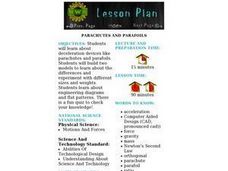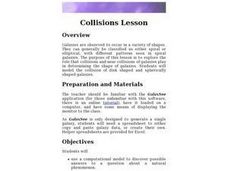Museum of Science
Gadget Anatomy: Understanding Machines
Students observe a machine closely from several angles while it operates. Identify the elements of machines combined in different gadgets. Create a clear diagram of how a machine works.
Curated OER
Solar System: Let's Take a Trip
Third graders consider outer space. For this introductory solar system lesson, 3rd graders complete a KWL chart and listen to the story The Magic School Bus: Lost in the Solar System, by Joanna Cole & Bruce Degen. They will...
Curated OER
Suspension Bridge Construction
Students study types, strength and construction of a variety of bridges. They build a model bridge and test the amount of weight it support.
Curated OER
Electric Field Mapping in 3D
Students create a 3D vector field map of an electric field. In this physics lesson, students measure the voltage inside an aquarium with water. They present their findings and map to class..
Curated OER
People and Space
Students eat dehydrated foods that the astronauts would eat in space. In this dehydrated foods lesson plan, students make lists of food they could eat, discuss how dehydration takes place, eat food, and complete discussion questions.
Curated OER
Converging Earthquake!
Middle schoolers identify the fault lines and tectonic plates on the map. In this earth science lesson, students simulate landscape formation using robots. They take a quiz at the end of the lesson to demonstrate mastery.
Curated OER
Simple Machines - Inclined Plane
Students learn the fundamentals and daily applications of simple machines.
Curated OER
Civil Engineering: Designing Bridges
Students examine the bridges of the United States. They discuss the concept of balance. They draw their own design of a suspension bridge.
Curated OER
Characteristics of Energy
Students explore Earth science by completing energy worksheets in class. In this energy forms lesson, students identify and define a list of energy vocabulary terms and a K-W-L chart. Students view a matter video clip in class and...
Curated OER
Collision Course
Students measure the speed of moving marbles and use the results to calculate velocity and momentum. They analyze the events preceding a Japanese train crash.
Curated OER
Mass
Students participate in a qualitative discussion of the distinction between weight and mass, followed by a description of astronaut mass measurements in a zero-g environment.
Curated OER
Sky and Cloud Windows
Young scholars monitor the weather, clouds, and sky. In this weather lesson, students create a sky and cloud window to focus their sky observations. They write observations in a notebook and include the date, time, cloud cover, types of...
Curated OER
Mandy
Third graders read Barbara D. Booth's, "Mandy" while noting each time they read a sensory detail. They read about the young girl in the story who is hard of hearing and determine how her other senses are heightened. Also, they determine...
Curated OER
Aerodynamic drag
Learners construct a device that can launch spinning balls. One example would be a mailing tube with one side partially cut away, lined with sandpaper. Styrofoam balls should be used for the greatest effet. They are explained how a...
Curated OER
Vectors
Students differentiate distance and displacement. In this physics activity, students use formulas to calculate for displacement. They draw vectors using the grid.
Curated OER
BRIDGE CONSTRUCTION
Young scholars explore how to build a bridge and test how much weight it can support.
Curated OER
Induction: Inquiry in Action
Students investigate the factors that affect the induced current in a loop of wire. They discuss Faraday's Law and Lenz's Law. Students identify the different variables that affect the magnetic flux and calculate the magnetic flux...
Curated OER
Taking Risks: Drug and Alcohol Abuse
Students discuss a video about drug and alcohol abuse and their connection to risk-taking. They answer questions on a risk factor sheet about the use of tobacco, drugs, and alcohol. They discuss long and short term goals and how not...
Curated OER
Virial Theorem Lesson
Ninth graders describe how equilibrium can occur as the balance of two effects. They model the stability of elliptical galaxies based on how fast stars within the galaxy are moving.
Curated OER
Parachutes And Parafoils
Young scholars study deceleration devices like parachutes and parafoils.
Curated OER
Fun with Balloons
Fifth graders design their own hot air balloon. In this science lesson, 5th graders investigate how factors like weight and sizes affect a balloon's lifting power. They also write math problems based on facts written in the...
Curated OER
Can You Make A Penny Float?
Students explore the concept of density by trying to make a penny and other materials float.
Curated OER
Collisions Lesson
Tenth graders explore the role that collisions and near collisions of galaxies play in determining the shape of galaxies. They model the collision of disk shaped and spherically shaped galaxies.


